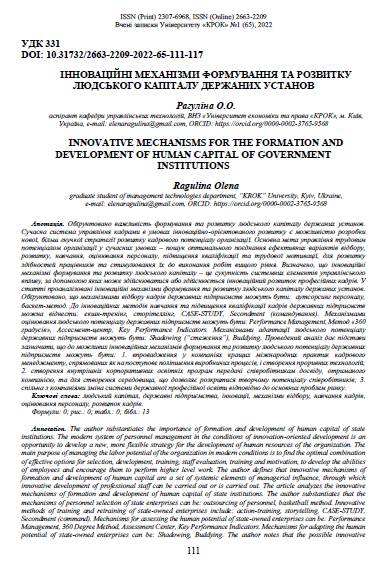INNOVATIVE MECHANISMS FOR THE FORMATION AND DEVELOPMENT OF HUMAN CAPITAL OF GOVERNMENT INSTITUTIONS
DOI:
https://doi.org/10.31732/2663-2209-2022-65-111-117Keywords:
human capital, state enterprises, innovations, selection mechanisms, personnel training, personnel evaluation, personnel developmentAbstract
The author substantiates the importance of formation and development of human capital of state institutions. The modern system of personnel management in the conditions of innovation-oriented development is an opportunity to develop a new, more flexible strategy for the development of human resources of the organization. The main purpose of managing the labor potential of the organization in modern conditions is to find the optimal combination of effective options for selection, development, training, staff evaluation, training and motivation, to develop the abilities of employees and encourage them to perform higher level work. The author defines that innovative mechanisms of formation and development of human capital are a set of systemic elements of managerial influence, through which innovative development of professional staff can be carried out or is carried out. The article analyzes the innovative mechanisms of formation and development of human capital of state institutions. The author substantiates that the mechanisms of personnel selection of state enterprises can be: outsourcing of personnel, basketball method. Innovative methods of training and retraining of state-owned enterprises include: action-training, storytelling, CASE-STUDY, Secondment (command). Mechanisms for assessing the human potential of state-owned enterprises can be: Performance Management, 360 Degree Method, Assessment Center, Key Performance Indicators. Mechanisms for adapting the human potential of state-owned enterprises can be: Shadowing, Buddying. The author notes that the possible innovative mechanisms for the formation and development of human potential of state enterprises may be: 1. introduction of the best international practices of personnel management in companies, aimed at the gradual improvement of production processes and the creation of breakthrough technologies; 2. creation of internal corporate educational programs to transfer to employees the experience gained by the company, and to create an environment that allows to reveal the creative potential of employees; 3. joint change with the companies of the system of state vocational education in accordance with the main problems of the market.
Downloads
References
Лапина Н. В., Рогова И. Ю., Рогов А. В. Развитие инновационной деятельности : теория и практика. Саратов : ИЦ СГСЭУ, 2003. С. 6.
Аитов Д. Ф. Управление кадровыми инновациями: аутсорсинг персонала. УЭкС. 2016. №10 (92). URL : https://cyberleninka.ru/article/n/upravlenie-kadrovymi-innovatsiyami-autsorsing-personala.
Chulanova O. L., Kvindt O. V., Chulanov D. V. Key (nuclear) competence management personnel to the strategic management of corporations. European International Conference on European Science and Technology : materials of the III international research and practice conference, Munich, Oktober 30-31, 2012. Vol. 1. C. 383-388.
Чуланова О. Л., Штибекова А. И. Применение баскет - метода в процедуре отбора персонала организации. Актуальные проблемы гуманитарных и естественных наук. 2015. №11-3. URL: https://cyberleninka.ru/article/n/primenenie-basket-metoda-v-protsedure-otbora-personala-organizatsii.
Пяткова О. Б. Метод сторителлинга в обучении. Школьные технологии. 2018. № 6. URL: https://cyberleninka.ru/article/n/metod-storitellinga-v-obuchenii.
Кречетников К. Г. Использование зарубежных методов обучения персонала в практике российских предприятий. Социально-экономические науки и гуманитарные исследования. 2015. №7. URL: https://cyberleninka.ru/article/n/ispolzovanie-zarubezhnyh-metodov-obucheniya-personala-v-praktike-rossiyskih-predpriyatiy.
Соколова Н. Б. Принципы функционирования системы управления персоналом. Контекст. 2015. № 3. С. 35-42.
Sadati L., Askarkhah A., Hannani S. Assessment of Staff Performance in CSSD Unit by 360 Degree Evaluation Method. Asia Pacific Journal of Health Management. 2021. Том 15, Вып. 4. С. 71-77.
Митрофанова Е., Софиенко А. Управление персоналом. Теория и практика. Аудит, контроллинг и оценка расходов на персонал. Москва : Дрофа, 2017. 78 с.
Сборовская В. М. Аспекты развития кадровой политики. Контекст. 2016. № 1. С. 45-51.
Тимофеев М. С. Экономический эффект внедрения социальной поддержки персонала. Контекст. 2016. № 9. С. 36-39.
Карпенко М. А. Опыт использования методов развития персонала Shadowing и Secondment в аутстаффинге. Human Progress. 2020. №3. URL: https://cyberleninka.ru/article/n/opyt-ispolzovaniya-metodov-razvitiya-personala-shadowing-i-secondment-v-autstaffinge.
Наставничество и сторителлинг как способы передачи знаний в рабочей среде. Е-xecutive сообщество менеджеров. URL: nowledge/announcement/349726/.



